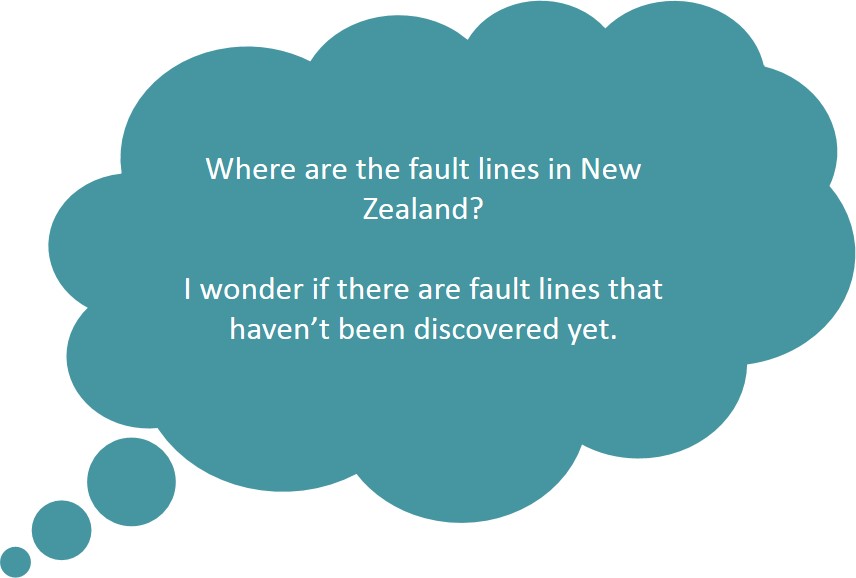You can contact LEARNZ, part of CORE Education, at:
Postal Address:
PO Box 13 678,
Christchurch 8141,
New Zealand
Around twenty thousand earthquakes are recorded each year in and around New Zealand, but only about 250 of these are felt. Earthquakes are caused when the stresses of plate tectonics break the rocks of the crust (a sudden movement). If the break reaches the surface a fault line is created.
A fault is a break in the rocks that make up the Earth's crust, along which rocks on either side have moved past each other. Sometimes the blocks of rock on either side of a fault suddenly shift to a new position in just a few seconds. This sudden release of energy sends out waves, which are felt on the surface as an earthquake. The strength of the earthquake depends on the area of fault that has shifted and the amount of movement. A small area and small movement creates a small earthquake.
The place where a fault ruptures is called the focus or origin, and the point directly above on the Earth’s surface is called the epicentre. The energy released by a fault movement radiates outwards as seismic waves, or shock waves.
Two types of seismic waves are created:
The P-wave (primary or pressure wave) is a pulse of energy that travels quickly through the Earth and through liquids. It forces the ground to move backwards and forwards as it is compressed and expanded (similar to the way sound waves move through air). It is often heard rather than felt.
the way sound waves move through air). It is often heard rather than felt.
The S-wave (secondary or shear wave) follows more slowly, shaking the ground up and down at right angles to the direction of the P-wave.
For centuries before Europeans arrived, Māori had experienced rū whenua which means ‘the shaking of the land’. According to Māori tradition, earthquakes are caused by the god Rūaumoko (or Rūamoko), the son of Ranginui (the Sky) and his wife Papatūānuku (the Earth).
Rangi had been separated from Papa, and his tears had flooded the land. Their sons resolved to turn their mother face downwards, so that she and Rangi would not see one another’s sorrow and grieve more. When Papatūānuku was turned over, Rūaumoko was still at her side and was carried to the world below. To keep him warm there he was given fire. He is the god of earthquakes and volcanoes, and the rumblings that disturb the land are made by him as he walks about.
Several accounts of earthquakes experienced by Māori were recorded by European writers. They described two major earthquakes, at Taupō and Rotorua. It was said that at Rotorua a pā with about 1,000 people was swallowed up, and the area became a lake.
Māori also spoke of two earthquakes along the Whanganui River in the 1830s. During the 1838 earthquake there were huge landslides into the river. These landslides caused a backwash in the river that left canoes stranded high up on the cliffs. Another earthquake in 1839 uplifted river boulders.
The most powerful New Zealand earthquake in recent history occurred in the Wairarapa in 1855. During this magnitude 8.2 earthquake, land moved along at least 140km of the Wairarapa Fault. Where the movement was greatest, the land shifted across more than 18 metres along the fault. Part of the nearby Rimutaka Range rose more than 6 metres. This is the biggest known movement by a single earthquake to have been recorded anywhere in the world.
All of New Zealand is prone to earthquakes. However, there is a variation in the level of earthquake activity across the country. Wellington is one of the most active of New Zealand’s seismic regions and Auckland one of the least active. Large earthquakes can still happen in regions with lower activity. This is best illustrated by the recent events in Christchurch.
Most of New Zealand’s seismic activity, including its major historic earthquakes, occurs within a broad zone of deformation (about 100km wide) that runs along the plate boundary from offshore East Cape to Fiordland.
Based on its seismic history, New Zealand should experience 50 magnitude 5 earthquakes and two magnitude 6 earthquakes each year, four magnitude 7 earthquakes per decade, and a magnitude 8+ earthquake every century. However, earthquakes are not evenly spread over time and they often occur in clusters. A damaging earthquake could happen at any time. At least 25 per cent of the population is expected to experience shaking great enough to damage household contents and buildings in the next 50 years.
You can find out more about earthquakes in New Zealand at http://www.geonet.org.nz/.

,Earthquakes happen in New Zealand every day but are usually too small to be felt. Some earthquakes, however, are large and have caused serious damage to property and even injured or killed people. Image: GNS Science.

,Shallow earthquakes usually break to the Earth’s surface to create faults. Image: Geological & Nuclear Sciences - Lincoln University.

,The energy released by a fault movement radiates outwards as seismic waves. There are two types of seismic waves; P-waves and S-waves. Image: GNS Science.

,The 1931 Napier earthquake left some roads badly damaged. Image: GNS Science.

The 22 February, Christchurch earthquake caused a lot of damage. Image: LEARNZ.
Check out the GeoNet recent earthquakes webpage to see if there have been any earthquakes today and where they were centred.